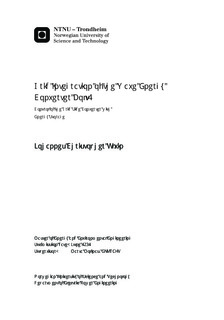| dc.contributor.advisor | Molinas, Marta | nb_NO |
| dc.contributor.author | Ulvin, Johannes Christopher | nb_NO |
| dc.date.accessioned | 2014-12-19T13:53:33Z | |
| dc.date.available | 2014-12-19T13:53:33Z | |
| dc.date.created | 2012-11-08 | nb_NO |
| dc.date.issued | 2012 | nb_NO |
| dc.identifier | 566425 | nb_NO |
| dc.identifier | ntnudaim:8269 | nb_NO |
| dc.identifier.uri | http://hdl.handle.net/11250/257374 | |
| dc.description.abstract | This thesis is written in cooperation with Fred Olsen's Wave Energy Project Bolt2 which is a Wave Energy Converter (WEC) recently deployed outside of Falmouth Bay in the UK. After the initial phases of testing, the device is to be grid connected to the local distribution network. The purpose of this thesis is to develop a model that can serve as a useful starting point for investigating grid connection issues for Wave Energy Converters or as a part of a complete wave-to-wire modelling of a WEC. The Bolt2 project will be used as a framework for the thesis. Measurements from the testing of Bolt2 have been provided and strengthen the project by applying real life conditions to the model.The work emphasizes on the challenges of grid connecting wave energy devices as motivation for the work. As a first step, the design of the grid side converter and its control system is carried out with the main criterion being a constant DC-link voltage. In addition, the control circuit ensures no reactive power exchange at the converter output that the currents are injected at the grid frequency. The control strategy applied is based on vector control due to its well documented performance in a variety of applications.One of the main barriers for wave energy developers are the large power variations that are inherent to most WECs since the produced wave power goes through zero twice in each wave period. An effective way of reducing the power fluctuations is by disposing several point absorbers in an array configuration which is one of the advantages of Fred Olsen's Bolt2.To further smooth out the power, an Energy Storage System (ESS) is considered. After a short discussion, the energy storage device was chosen to be a supercapacitor (SC) bank. Initially, the possibility to provide a constant power to the grid was investigated but was rejected as being unrealistic for a practical case. Instead, an alternative power management strategy of the ESS was developed. It was decided to chop off only the largest power peaks and to discharge whenever any amount of energy remained in the SCs for the storage system to be completely discharged and prepared for any incoming power peak. A bi-directional DC-DC converter was used to interface the SCs with the DC-link and the described power management strategy was realized through current control of the switching devices. Two similar but separate control schemes were necessary in order to perform both buck charging and boost discharging.Finally, simulations of power data from a design sea state were performed in order to prove the validity of the developed model. The peak-to-average power ratio was demonstrated to be reduced with the integration of the energy storage system. However, the expenses of including a storage would have to be justified by reduced costs for the developer in order for the scenario to be economically viable. | nb_NO |
| dc.language | eng | nb_NO |
| dc.publisher | Institutt for elkraftteknikk | nb_NO |
| dc.subject | ntnudaim:8269 | no_NO |
| dc.subject | MTENERG energi og miljø | no_NO |
| dc.subject | Elektrisk energiteknikk | no_NO |
| dc.title | Grid Integration of the Wave Energy Converter Bolt2: Control of the Grid Side Converter with Energy Storage | nb_NO |
| dc.type | Master thesis | nb_NO |
| dc.source.pagenumber | 102 | nb_NO |
| dc.contributor.department | Norges teknisk-naturvitenskapelige universitet, Fakultet for informasjonsteknologi, matematikk og elektroteknikk, Institutt for elkraftteknikk | nb_NO |

